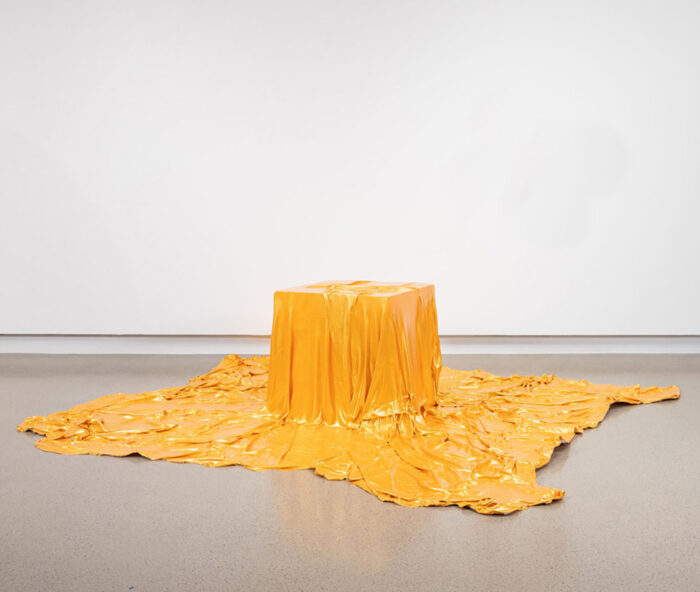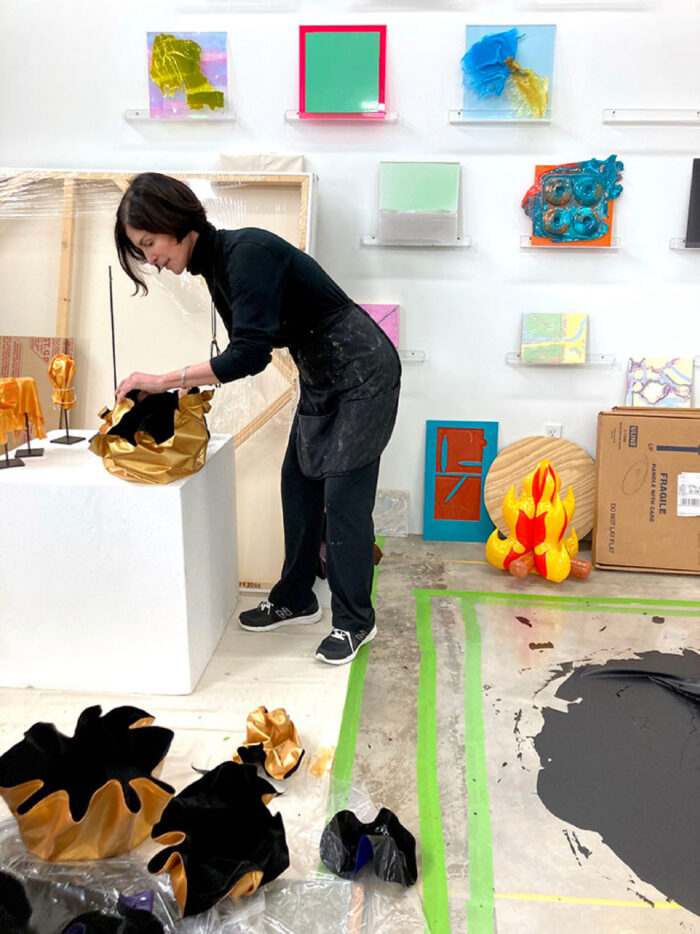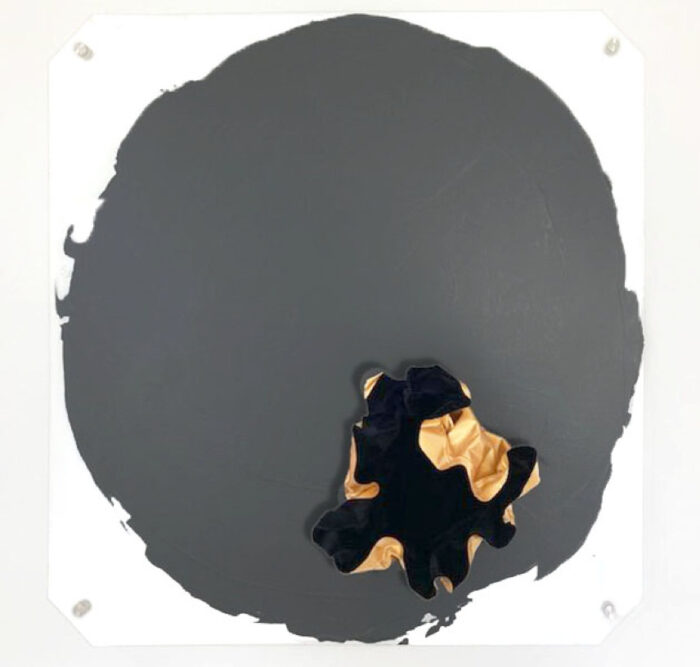
Lesley Bodzy is an artist whose work defies categorization. Part painting, part sculpture, her creations are made almost as a meditative performance. The artist pours acrylic paint to form skins that she hangs and drapes into various forms, achieving compositions that are poetic, feminine, and layered with personal and shared meaning. Often working through complex emotions, including themes of trauma, desire, and the experience of being a woman, her work is as profoundly meaningful as it is visually captivating. A recent graduate of the School of the Art Institute of Chicago’s studio art MFA program, Bodzy has been exhibited widely in galleries in New York and Houston, two cities she calls home. We spoke with the artist as she prepares for her latest project, a shared presentation at this year’s SPRING/BREAK art fair in New York, and some of the life-changing events that brought her there.
Annabel Keenan: Before diving into your current work and your exciting presentation at SPRING/BREAK, I’d love to know more about your background. When did you first start making art?
Lesley Bodzy: I have always made art. I grew up in Los Angeles and I was interested in arts and crafts from a very young age. I enjoyed the feeling of escape that the process of art-making brought me and the feeling of accomplishment that comes with having made something.
For many years, I was away from art-making while I was working in the corporate world, during which time I engaged in it as a casual pastime. I got very serious about it later in life and took classes at the Art Students League and Hunter College before going back to school for my MFA in studio art at the School of the Art Institute of Chicago. Graduate school helped me to find my own voice and the meaning behind the work I’d been making subconsciously.
I began as a painter of still life, using watercolors. I progressed to oil paint still life, and then branched out into large abstract canvases, using acrylic. I became fascinated with the plastic nature of acrylic paint and started using it as a sculptural material, making small hanging and standing sculptures entirely of poured paint. I gradually enlarged them to the big sizes you see today.

AK: The acrylic skins, as they appear, are stunning. It’s impossible not to think of Lynda Benglis and her iconic work in which she pigmented rubber latex and poured it onto her studio floor. I know you’ve mentioned Benglis as an influence, as well as Lynn Umlauf and Merrill Wagner. What specifically about their work inspires you?
LB: They are all feminist sculptors who cared deeply about materiality, experimented with unusual materials, and blurred the line between painting and sculpture. They also each, at some juncture in their practices, explored the fluidity of folds as a means to evade the structures of classicism.
Lynn Umlauf influenced me to move from painting to sculpture. She envisioned a painting as a series of shapes and a surface to be carved into. She believed that the surface and materials used were more important than capturing a likeness or how the painting looked when finished. She moved into wall sculptures, integrated found materials, and, eventually, her works left the wall to become freestanding and hanging sculptures. My practice has followed this trajectory too.
With Merrill Wagner, I was inspired by her emphasis on minimalism. Over four decades, she has created minimalistic artwork around the themes of time and transformation, using steel, slate, and plexiglass.
As you noted, Lynda Benglis influenced me to pour paint and experiment with other materials that can be poured. She is a trailblazer both in her outspoken feminism and she was the first to take the paint off the canvas and pour it onto the floor.

AK: You mentioned you’re on your way to New York right now, do you spend most of your time in Houston these days?
LB: Yes, I am en-route to NYC to participate in SPRING/BREAK. I have a big studio in Houston where I do most of the work and a small space in NYC that I have turned into a gallery where I show my work to New York and international galleries and collectors. I have a “rom-com“ reason for being in two cities: I met my husband later in life (6 years ago), and he’s a Houstonian and I’m a New Yorker. So, we go back and forth between cities.
AK: Nice to be able to tap into both markets and audiences. One of the striking things about your work, especially your recent work, is that it’s monochromatic, or uses just a few colors. How do you choose the colors in your work?
LB: As I mentioned before, I began as a painter of still life using watercolor and then oil paint. When I branched out into geometric abstraction and started using acrylic paint, I also began studying color theory with the inspirational professor Gabriele Evertz at Hunter College. I’ve consciously used color theory ever since and I am fascinated by the monochromatic.
For the past two years, I’ve been working with shades of gold. The color gold is used to make sculptures that have a feminist message and explore beauty. I chose gold to symbolize the veneer women are encouraged to present to the world.
It’s funny–you might think I am uninterested in color because I’ve been focused on gold for two years now! I do love color and monochromatic palettes. There is a very insightful book on the psychology behind monochrome called Chromophobia by David Batchelor. I’ve made a lot of paintings using unusual color combinations and I really enjoy color theory. My next series is based on sea slugs, which are a highly colorful species that is endangered due to our pollution of the oceans.

AK: Your work explores themes of loss, trauma, and desire, do you channel specific moments or feelings when creating new work?
LB: Yes. Absolutely. When I make a work, I think of a present or past trauma or feeling. It can also be a romantic one depending on the piece. At the same time, I keep a journal and write poems about the event. I’m very immersed in feelings during the period I am making the work. In my twenties, I studied acting in NYC and we learned about the exercise of “sense memory.” Here, if the character you are playing needs to cry for a scene, for example, the technique is to think of a past event that caused you to cry while you are saying the lines. Thinking of the event will cause it to be present in the moment.
AK: That’s very powerful and immersive. Can you tell me more about Is This Desire? I read about the heartbreaking reasons for making the project.
LB: Is This Desire? is a series of four monumental gold sculptures, made of gold acrylic paint used as a sculptural material. The gold drapes are essentially paint skins used as facades, membranes, shrouds, and veils. The gold draperies allude to the shiny veneer we each present to the world. Taught to play roles that please our parents and society throughout our childhood, our challenge as adults is to seek our true selves.
My father was hospitalized in November 2020 and died of covid in January 2021. He was 92 years old and unconscious for all but 36 hours of his ordeal. During this period, I wrote a series of poems reflecting on what it was like growing up in a patriarchal home and how ancient family roles were present even as my father was dying. I made the sculptures for the Is This Desire? series based off of this trauma.
AK: I’m really sorry to hear that, such a horrible tragedy and difficult event to process.
LB: Thank you. This series attempts to process and visualize the invisible pressures many women endure while conforming to the golden standard of stereotypical femininity. Although much progress has been made since I was a young woman, I think society still values a woman’s beauty over her mind or character. This relates to my work at SPRING/BREAK too. Each work is a meditation on the patriarchal logic of power and a feminist logic shaped by resilience, vulnerability, and strength.

AK: Thank you for sharing that. You recently completed a great series also related to the treatment of women called Lupercalia, a reference to the ancient Roman pagan ritual that involves animal sacrifice for the sake of purification. Women are beaten with these sacrificed animals, which was thought to support fertility. As you mention in the description of the work on your website, Chaucer and Shakespeare washed away this darker origin and reframed the idea as the sweet and romantic Valentine’s Day that we know today. How did you decide to make this series?
LB: With Lupercalia, I wanted to summon the darker side of the festivity by reaching underneath the veneer that conceals the suffering and violence from which it originated. Each thin and yet resistant veil is a manifestation of the anxiety, apprehension, and disquiet many feel as this day approaches, along with its demands, expectations, and desires. The series invites us to reconsider the heartache that is entailed in loving someone. I made it specifically for a Valentine’s Day themed show in 2022 at Incubator Studio Gallery in Bushwick, Brooklyn. It was the first time I referenced ancient history, but I always do original research when I create my works. I also liked the Lupercalia history as I think Valentine’s Day is highly commercial and excludes lots of people, so I wanted to reference dark, menacing valentines rather than hearts and flowers.

AK: This all brings us to today and your upcoming presentation at SPRING/BREAK. Titled “Leftover and Over,” the display was curated by Dr. Giovanni Aloi, art historian and professor at the School of the Art Institute of Chicago, and Erica Criss of Criss Collaborations. Can you share what you’re showing at SPRING/BREAK?
LB: The works I’m showing are similar to the Is this Desire? series, but more recent. They were made in 2022 and are four works from my recent solo show, Fold of Desire at Yvonamor Palix Gallery in Houston. The works are titled Dialogue, Soft Embrace, Eclipse, and I knew better. I’m presenting alongside my classmate from SAIC, Andrew Orloski, who is a talented sculptor. The theme of the fair is “Naked Lunch,” so we’re exploring this theme through an interpretation of the aftermath of Manet’s Luncheon on the Grass, (1863).
Similar to the meaning of the golden veils in Is This Desire?, the veils in SPRING/BREAK are reimaginations of Venus’ drapes of modesty and decorum—vibrant visualizations of vulnerability, the aftermath of everyday traumas that still define women’s lives today. Thin and yet resistant, the veils allude to the vulnerability of many women who, oppressed by patriarchal institutions, must conceal feelings and emotions beneath a veneer of objectified and appealing perfection. This also relates to the treatment of women addressed in Lupercalia.
AK: Your works really build upon earlier projects and tell a complex story of what it means for you to be a woman, and the experience of women in general today and throughout history. I’m looking forward to seeing these stunning pieces at the fair. Thank you for chatting with me.
LB: Thanks so much, Annabel!
SPRING/BREAK: Naked Lunch runs September 7 to 12 at 625 Madison Avenue
Annabel Keenan is a New York-based writer specializing in contemporary art and sustainability. Her work has been published in The Art Newspaper, Cultbytes, Hyperallergic, and Artillery Magazine, among others.
